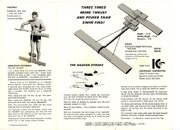2airishuman
Contributor
I dive local lakes and rivers.
I have experimented with "minimalist" rigs and made several dives with an old-school plastic "backplate," no octo, no BC, the idea being to streamline and maybe have an inexpensive set of gear I can leave in the back of the car, bottom of the boat, etc. I experimented with various sizes of cylinders, like you propose. I got a Calypso J regulator and experimented with diving without an SPG.
After becoming familiar with the setup I concluded that there weren't any advantages.
I dive a backplate and wing on all my dives now. I dive LP72s on shallow dives. I use primary donate with a necklaced secondary. My rig is well streamlined and with some small adjustments gives me everything I need for a wide variety of dives. Everything is always in the same spot and works the way I expect it. I like my rig. I like having a BC. I like having plenty of air.
A smaller/lighter rig isn't enough smaller, enough lighter, or enough more streamlined than what I usually dive to make a meaningful difference.
Lots of hazards in rivers. Be aware that in current you may get stuck on a "strainer" i.e. pinned against an obstruction by the current. Be aware that logs/branches/trees may move so that they trap you under them. Carrying a hand saw is sometimes a prudent precaution. Viz is poor in many cases.
Enjoy, be safe
I have experimented with "minimalist" rigs and made several dives with an old-school plastic "backplate," no octo, no BC, the idea being to streamline and maybe have an inexpensive set of gear I can leave in the back of the car, bottom of the boat, etc. I experimented with various sizes of cylinders, like you propose. I got a Calypso J regulator and experimented with diving without an SPG.
After becoming familiar with the setup I concluded that there weren't any advantages.
I dive a backplate and wing on all my dives now. I dive LP72s on shallow dives. I use primary donate with a necklaced secondary. My rig is well streamlined and with some small adjustments gives me everything I need for a wide variety of dives. Everything is always in the same spot and works the way I expect it. I like my rig. I like having a BC. I like having plenty of air.
A smaller/lighter rig isn't enough smaller, enough lighter, or enough more streamlined than what I usually dive to make a meaningful difference.
Lots of hazards in rivers. Be aware that in current you may get stuck on a "strainer" i.e. pinned against an obstruction by the current. Be aware that logs/branches/trees may move so that they trap you under them. Carrying a hand saw is sometimes a prudent precaution. Viz is poor in many cases.
Enjoy, be safe




